NCERT Exemplar: Transport in Plants (Old NCERT) | Biology for Grade 11 PDF Download
| Table of contents |

|
| Multiple Choice Questions |

|
| Very Short Answer Type Questions |

|
| Short Answer Type Questions |

|
| Long Answer Type Questions |

|
Multiple Choice Questions
Q.1. Which of the following statements does not apply to reverse osmosis?
(a) It is used for water purification.
(b) In this technique, a pressure greater than the osmotic pressure is applied to the system.
(c) It is a passive process.
(d) It is an active process.
Ans. (c)
Solution: If pressure greater than the osmotic pressure is applied to the higher concentration, the direction of water flow through the membrane can be reversed. This is called reverse osmosis. Reverse osmosis occurs when water is moved across the membrane against the concentration gradient, from lower concentration to higher concentration. Reverse osmosis is an active process.
Q.2. Which one of the following will not directly affect transpiration?
(a) Temperature
(b) Light
(c) Wind speed
(d) Chlorophyll content of leaves
Ans. (d)
Solution: The chlorophyll content of leaves will not directly affect transpiration, while temperature, light and wind speed directly affect the transpiration.
Q.3. The lower surface of leaf will have more number of stomata in a
(a) Dorsiventral leaf
(b) Isobilateral leaf
(c) Both a and b
(d) None of the above
Ans. (a)
Solution: Usually, the lower surface of a dorsiventral (dicotyledonous) leaf has a greater number of stomata. On the upper surface, stomata maybe even absent sometimes.
Q.4. The form of sugar transported through phloem is
(a) Glucose
(b) Fructose
(c) Sucrose
(d) Ribose
Ans. (c)
Solution: Food, primarily sucrose, is transported by the vascular tissue phloem from a source to a sink.
Q.5. The process of guttation takes place
(a) When the root pressure is high and the rate of transpiration is low
(b) When the root pressure is low and the rate of transpiration is high
(c) When the root pressure equals the rate of transpiration
(d) When the root pressure, as well as the rate of transpiration, are high
Ans. (a)
Solution: The effect of root pressure is observable at night as well as the early morning when evaporation is low. Excess water gets collected in the form of droplets around special openings of veins near the tip of grass blades and leaves of many herbaceous parts of plants such as Tropaeolum, Balsam, and grasses. Such water loss in its liquid phase is known as guttation.
Q.6. Which of the following is an example of imbibition
(a) Uptake of water by root hair
(b) Exchange of gases in stomata
(c) Swelling of seed when put in soil
(d) Opening of stomata
Ans. (c)
Solution: Imbibition is a special type of diffusion. A classic example of imbibition is absorption of water by seeds and dry wood.
Q.7. When a plant undergoes senescence, the nutrients may be
(a) Accumulated
(b) Withdrawn
(c) Translocated
(d) None of the above
Ans. (c)
Solution: Mineral ions are frequently remobilized (translocation), particularly from older senescing parts. Before the leaf fall in deciduous plants, minerals are translocated to other parts.
Q.8. Water potential of pure water at standard temperature is equal to
(a) 10
(b) 20
(c) Zero
(d) None of the above
Ans. (c)
Solution: The water potential of pure water at standard temperature is equal to zero.
Q.9. Mycorrhiza is a symbiotic association of fungus with root system which helps in
A. Absorption of water
B. Mineral nutrition
C. Translocation
D. Gaseous exchange
Options:
(a) Only A
(b) Only B
(c) Both A and B
(d) Both B and C
Ans. (c)
Solution: Mycorrhiza is a symbiotic association of fungus with root system which helps in absorption of water and mineral nutrition.
Q.10. Based on the figure given below which of the following statements is not correct?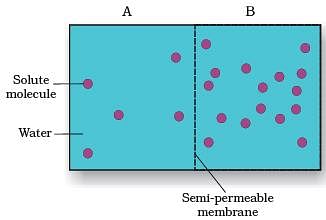 (a) Movement of solvent molecules will take place from chamber A to B.
(a) Movement of solvent molecules will take place from chamber A to B.
(b) Movement of solute will take place from A to B.
(c) Presence of a semipermeable is a pre-requisite for this process to occur.
(d) The direction and rate of osmosis depends on both the pressure gradient and concentration gradient.
Ans. (b)
Solution: The movement of solute will take place from B to A.
Q.11. Match the followings and choose the correct option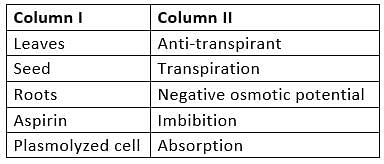
Options:
(a) A-ii, B-iv, C-v, D-i E-iii
(b) A-iii, B-ii, C-iv, D-i E-v
(c) A-i, B-ii, C-iii, D-iv E-v
(d) A-v, B-iv, C-iii, D-ii E-i
Ans. (a) A-ii, B-iv, C-v, D-i E-iii
Solution: Transpiration happens mainly through stomata which are present on leaves. 'A' is being matched with 'ii' only in this option hence option 'a' is the correct answer.
Q.12. Mark the mismatched pair.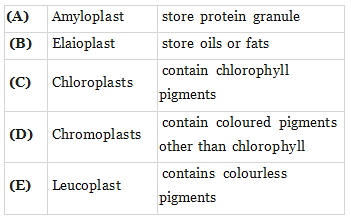
Ans. (a)
Solution: Aleuroplasts—Store proteins
Amyloplast—Store carbohydrate (starch)
Very Short Answer Type Questions
Q.1. Smaller, lipid-soluble molecules diffuse faster through cell membrane, but the movement of hydrophilic substances are facilitated by certain transporters which are chemically ______.
Ans. Protein
Q.2. In a passive transport across a membrane, when two different molecules move in opposite direction and independent of each other, it is called as ______.
Ans. Antiport
Q.3. Osmosis is a special kind of diffusion, in which water diffuses across the cell membrane. The rate and direction of osmosis depends upon both ______.
Ans. Pressure and concentration gradient
Q.4. A flowering plant is planted in an earthen pot and irrigated. Urea is added to make the plant grow faster, but after some time the plant dies. This may be due to ______.
Ans. Exosmosis
Q.5. Absorption of water from soil by dry seeds increases the ______, thus helping seedlings to come out of soil
Ans. Pressure
Q.6. Water moves up against gravity and even for a tree of 20m height, the tip receives water within two hours. The most important physiological phenomenon which is responsible for the upward movement of water is______.
Ans. Transpiration pull
Q.7. The plant cell cytoplasm is surrounded by both cell wall and cell membrane. The specificity of transport of substances are mostly across the cell membrane, because ______.
Ans. The cell wall is freely permeable to water and substances in solutions but membrane is selectively permeable.
Q.8. The C4 plants are twice as efficient as C3 plants in terms of fixing CO2 but lose only ______ as much water as C3 plants for the same amount of CO2 fixed.
Ans. Half
Q.9. In a plant, translocation in xylem is unidirectional while in phloem it is bidirectional. Explain.
Ans. The direction of movement in the phloem can be upwards or downwards, i.e. bi-directional. This contrasts with that of the xylem where the movement is always unidirectional, i.e. upwards. Hence, unlike one-way flow of water in transpiration, food in phloem sap can be transported in any required direction, as it is a source of sugar and works as a sink to use, store or remove the sugar.
Q.10. Identify the process occurring in I, II and III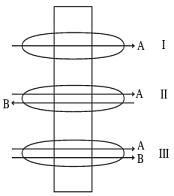 Ans.
Ans.
I—Uniport facilitated diffusion
II— Antiport facilitated diffusion
III— Symport facilitated diffusion
Q.11. Given below is a table. Fill in the gaps
Ans.
Q.12. Define water potential and solute potential.
Ans.
- Water potential is considered as the potential energy of water. It is also taken as a measure of the difference between the potential energy in a given sample of water and pure water.
- If a solute is dissolved in pure water, the solution is considered having fewer free water and hence the concentration of water decreases. Thus, all solutions have lower water potential than pure water. The magnitude of lowering in water potential due to dissolution of solute is called solute potential.
Q.13. Why is solute potential always negative? Explain yw = ys + yp
Ans. When a solute is dissolved in water, it reduces the water potential because the concentration of water in a solution is less than that in pure water. The measure of reduction in water pollution because of solute is called solute potential. Since solute potential always has a negative impact on water potential, so its value is always negative.
For a solution at atmospheric pressure, its water potential is equal to solute potential. When a pressure greater than atmospheric pressure is applied, then water potential of the solute increases.
This is illustrated by following equation:
yw = ys + yp
Here; yw is water potential, ys is solute potential and yp is pressure potential.
Q.14. Tradescantia leaf epidermal peel was taken and
(a) Placed in salt solution for five minutes.
(b) After that it was placed in distilled water.
When seen under the microscope what would be observed in a and b?
Ans.
- In case of ‘a’ the cells of onion peel would lose water. This will show shrunk cells in microscope.
- In case of ‘b’ the cells of onion peel would gain water. This will show normal cells in microscope.
- In both cases, movement of water takes place because of osmotic gradient.
Q.15. Differentiate between Apoplast and Symplast pathways of water movement. Which of these would need active transport?
Ans.
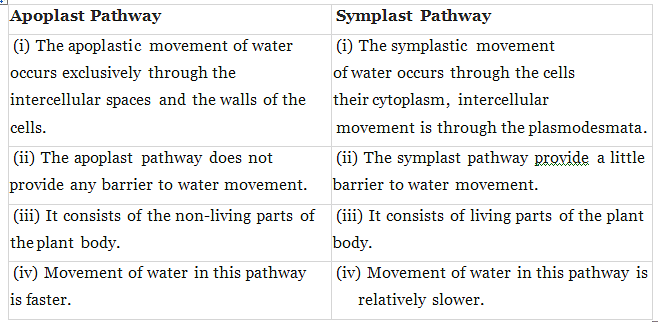
None of these pathways need active transport.
Q.16. How does water moves within the root?
Ans. Most of the water moves within the root through apoplast pathway since the cortical cells are loosely packed. Only a minor portion of water moves through symplast pathway. Presence of casparian strip prevents water movement through apoplast pathway. In that case, symplast pathway is the preferred pathway for movement of water.
Q.17. Give the location of Casparian strip and explain its role in the water movement.
Ans. Casparian strip is present at the boundary of the endodermis. It is made up of suberin. Casparian strip is impervious to water and thus water cannot enter it through apoplast pathway. Water needs to enter the vascular bundle through symplast pathway.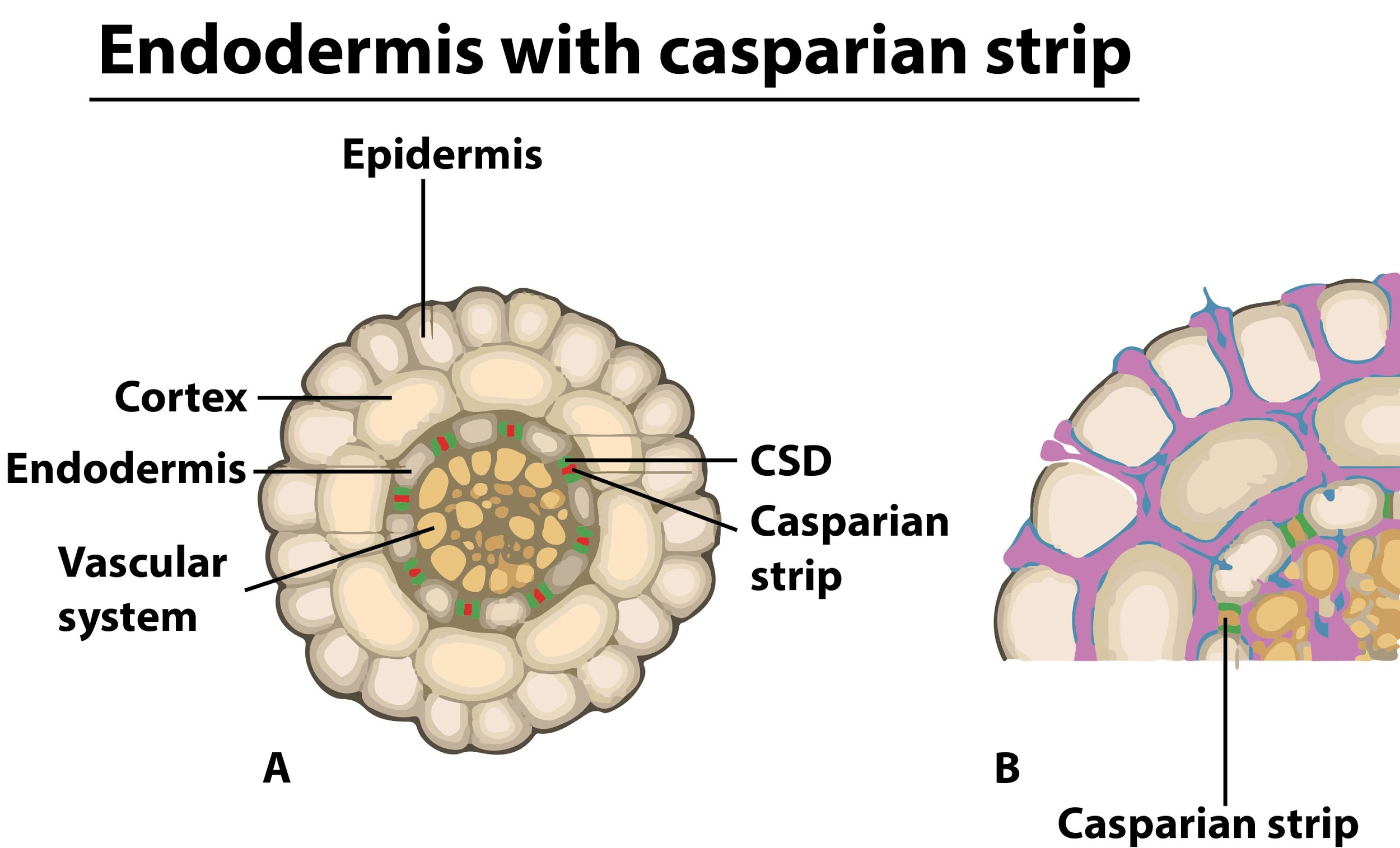
Q.18. Differentiate between guttation and transpiration.
Ans.
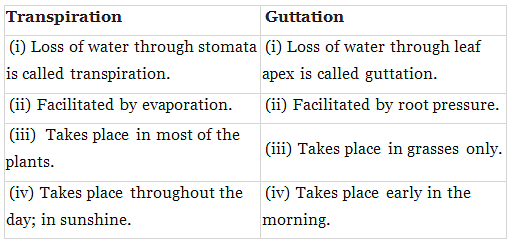
Q.19. Transpiration is a necessary evil in plants. Explain.
Ans. Transpiration plays important role in plant physiology. Transpiration creates the transpiration pull which is responsible for ascent of sap, especially in tall plants. Transpiration also helps in getting rid of excess water. But transpiration leads to a huge wastage of water which could otherwise been conserved. Only a minuscule fraction of water reaching to the leaves is utilized for photosynthesis and rest of it is wasted through transpiration. But since transpiration plays an important role in ascent of sap, so it is called a necessary evil.
Q.20. Describe briefly the three physical properties of water which helps in ascent of water in xylem.
Ans. Following are the three physical properties of water which help in ascent of water in xylem.
1. Cohesion: The ability of water molecules to stick to each other is called cohesion.
2. Adhesion: The ability of water molecules to stick to a surface is called adhesion.
3. Surface Tension: Any liquid has the tendency to occupy the smallest possible surface area. This property is called surface tension.
Adhesion cohesion and surface tension enable water to make a continuous column of water in the xylem vessels. Thus, water is pulled as a column by the transpiration pull.
Q.21. A gardener forgot to water a potted plant for a day during summer, what will happen to the plant? Do you think it is reversible? If yes, how?
Ans. If a potted plant is not watered for a day during summer, the plant will wilt. This happens because of excessive water loss due to transpiration. In most of the cases, this is reversible by watering the plant in time. But if a long delay is made then, the plant cannot be revived.
Q.22. Identify a type of molecular movement which is highly selective and requires special membrane proteins, but does not require energy.
Ans. The type of molecular movement which is highly selective and require special membrane proteins, but does not require energy is called facilitated diffusion. Diffusion of any substance across a membrane depends on its solubility in lipid. If a substance has hydrophilic moiety, it cannot diffuse through a membrane.
To facilitate the diffusion of such a molecule, special membrane proteins are present. In this case also, diffusion takes place from higher concentration to lower concentration and hence energy is not spent in the form of ATP. Facilitated diffusion is highly selective. It allows cells to select particular substances for energy.
Q.23. Correct the statements
(a) Cells shrink in hypotonic solutions and swell in hypertonic solutions
(b) Imbibition is special type of diffusion when water is absorbed by living cells.
(c) Most of the water flow in the roots occurs via the symplast.
Ans. (a) Cells swell in hypotonic solutions and shrink in hypertonic solutions.
(b) Imbibition is a special type of diffusion when water is absorbed by solids - colloids.
(c) Most of the water flow in the roots occurs via the apoplast.
Short Answer Type Questions
Q.1. Minerals absorbed by the roots travel up the xylem. How do they reach the parts where they are needed most? Do all the parts of the plant get the same amount of minerals?
Ans. Minerals are supplied to different plant parts according to the need. Once minerals are in the xylem, they are transported because of the transpiration pull.
They go up to a cell through passive transport and then taken up by the cell through active transport. Young and growing parts of a plant need more minerals and hence these parts are supplied with mote minerals.
Relocation of minerals also takes place in a plant. Minerals get relocated to the parts where they needed most from the old and seducing parts. Thus, plant ensures optimum utilization of minerals.
Q.2. If one wants to find minerals and in the form they are mobilised in the plant, how will an analysis of the exudate help?
Ans. An Analysis of xylem exudates helped up in recognizing the forms and ways in which minerals transported in plant.
Example: The analysis of xylem exudates has revealed that most of the nitrogen is transported in the form of organic molecules rather than in the form of inorganic molecules. Small amounts of phosphorus and Sulphur are transported in the form of organic compounds. Some exchange of materials also takes place between xylem and phloem. So, it cannot be clearly said that xylem transports only inorganic compounds and phloem transports only organic compounds.
Q.3. From your knowledge of physiology can you think of some method of increasing the life of cut plants in a vase?
Ans. The life of a cut plant can be increased by the following methods:
(a) Immediately put the cut plant in water.
(b) Some mineral nutrients should be added to water.
(c) A spray of hormone cytokinin also helps in prolonging the life of the cut plant.
Q.4. Do different species of plants growing in the same area show the same rate of transpiration at a particular time? Justify your answer.
Ans. Plant factors which affect the rate of transpiration are: number and distribution of stomata, percent of open stomata, water status, canopy structure, etc.
These factors may be different in different plant species. Thus, different species in the same area may show different rates of transpiration at a particular time.
Q.5. Water is indispensable for life. What properties of water make it useful for all biological processes on the earth?
Ans. Following properties of water make it useful for all biological processes on the earth.
- Water is a universal solvent, which means it can dissolve most of the substances.
- Water is the major component of protoplast and thus a major ingredient of all the cells.
- In case of external fertilization in animals, water is the medium through which the male gamete travels up to the female gamete.
- Oxygen easily dissolves in water and thus becomes available for breathing by aquatic organisms.
- In many plants, water is an agent of pollination.
- Water helps in temperature control in living beings because specific, heat of water helps in attaining cooling effect.
Q.6. How is the intracellular levels of ions maintained higher than extracellular levels in animal cells?
Ans. The membrane potential of a quiescent cell is relatively static. This stage is called resting potential. When a cell membrane is in resting potential, then intracellular levels of K+ are higher than extracellular levels in animal cells. This is brought about by Na+/K+ -ATPase which is also called sodium/proton pump. This pump makes 2K+ ions to enter the cell for every 3Na+ ions leaving the cell. Thus, for every 3 positive charges going out; only 2 positive charges go in. This results in a higher concentration of K+ inside the cell than outside it.
Q.7. Cut pieces of beetroot do not leave colour in cold water but do so in hot water. Explain.
Ans. When cut pieces of beetroot are kept in hot water, it results in leakage of the plasma membrane. As a result, beetroot pigments are released in water and water becomes coloured.
In case of cold water, the temperature is not enough to cause leakage in plasma membrane and hence beetroot pieces do not leave colour in cold water.
Q.8. In a girdled plant, when water is supplied to the leaves above the girdle, leaves may remain green for some time then wilt and ultimately die. What does it indicate?
Ans. In a girdled plant, when water is supplied to the leaves above the girdle, leaves remain green for some time. This happens because leaves can carry on photosynthesis in the presence of water. But leaves are unable to translocate the food prepared by them because girdling also results in damage to the phloem. This will finally result in death of the leaves above the girdle; even if they are given a regular supply of water.
Q.9. Various types of transport mechanisms are needed to fulfill the mineral requirements of a plant. Why are they not fulfilled by diffusion alone?
Ans. Minerals are present in the form of ions in soil. Mineral ions cannot move across root walls through diffusion because concentration of minerals in roots is always more than that in soil. Another reason is, charge particles cannot move across cell membranes. Hence, mineral requirements of plant cannot be met by diffusion alone.
Q.10. How can plants be grown under limited water supply without compromising on metabolic activities?
Ans. When a plant gets limited water supply, it brings some changes in physiology to conserve water.
Example: In xerophytes water loss is prevented by preventing transpiration. Even in normal plants, leaves wilt during summer days in order to prevent excessive transpiration. Thus, plants have learnt to manage with limited supply of water and they can carry on other metabolic activities.
Q.11. Will the ascent of sap be possible without the cohesion and adhesion of the water molecules? Explain.
Ans. Root pressure, capillary action, adhesion-cohesion and transpiration are the factors involved in ascent of sap in plants. Root pressure can only result in movement of water up to the base of the stem. Capillary action can raise the water only up to a few centimeters and hence can be effective in herbs only. Transpiration pull will only work when there is a water column underneath to be pulled. Hence, it is clear that ascent of sap is not possible without adhesion-cohesion of water molecules.
Q.12. Keep some freshly cut flowers in a solution of food colour. Wait for sometime for the dye to rise in the flower, when the stem of the flower is held up in light, coloured strands can be seen inside. Can this experiment demonstrate which tissue is conducting water up the stem?
Ans. Coloured strands show that there is a continuous column of water through the stem. We have seen that water molecules make continuous column because of adhesion-cohesion. We have also seen that water moves through xylem in plants. Hence, this experiment can demonstrate that xylem is conducting water up the stem.
Q.13. When a freshly collected Spirogyra filament is kept in a 10% potassium nitrate solution, it is observed that the protoplasm shrinks in size:
(a) What is this phenomenon called?
(b) What will happen if the filament is replaced in distilled water?
Ans.
(a) This phenomenon is called plasmolysis.
(b) When the filament is replaced in distilled water, it will result in water entering the cells. Cells would once again come to their original shape and size.
Q.14. Sugar crystals do not dissolve easily in ice-cold water. Explain
Ans. The kinetic energy of water reduces with reduction in temperature. Hence, sugar crystals can quickly dissolve in hot water. They will take some more time to dissolve in water at room temperature. They will take even longer time to dissolve in ice-cold water.
Q.15. Salt is applied to tennis lawns to kill weeds. How does salting tennis lawns help in killing of weeds without affecting the grass?
Ans. This is a misconception that applying salt will only kill weeds and will not affect grass. When salt is applied to a plant. water from plant cells come out because of osmosis. Excessive loss of water kills the plant cells and eventually the plant. Applying salt to weeds is a popular practice among gardeners but it has its own drawbacks. Salt can also damage the useful plants.
To limit the damage to useful plants, salt is used as solution in water and care is taken to directly sprinkle the weeds only with this solution. So, using salt as a weedicide is not a full-proof method of getting rid of weeds without damaging the useful plants.
Q.16. What is the chemical composition of xylem and phloem sap?
Ans. Exudates of xylem and phloem have been studied. The xylem sap mainly contains inorganic compounds. Most of the sulphur and potassium are in the form of inorganic compound. However, most of the nitrogen is in the form of organic compound.
In case of phloem sap also, both organic and inorganic compounds are found. Organic compounds are more in phloem sap because it carries the food. But it also has inorganic compound because exchange of materials takes place between phloem and xylem.
Q.17. Observe the figure and answer the question provided below the figure.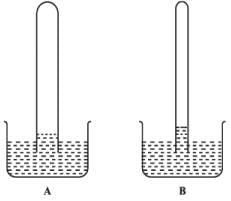 Ans. The lumen of tube B is smaller than that of A. Tube B creates more capillary effect than tube A because of smaller lumen. Due to this, the water rises higher in tube B than in tube A.
Ans. The lumen of tube B is smaller than that of A. Tube B creates more capillary effect than tube A because of smaller lumen. Due to this, the water rises higher in tube B than in tube A.
Q.18. What are ‘aquaporins’? How does presence of aquaporins affect osmosis?
Ans. Aquaporins are integral membrane proteins. They belong to a large family of Major Intrinsic Proteins (MIP). Aquaporins form pores in membranes of biological cells. Aquaporins hasten the rate of osmosis.
Q.19. ABA (Abscisic acid) is called a stress hormone.
(a) How does this hormone overcome stress conditions?
(b) From where does this hormone get released in leaves?
Ans. (a) In case of scarcity of water, ABA gives signal to stomata. This results in stomata getting closed. Thus, transpiration is stopped and water is conserved. This explains how ABA overcomes stress situations.
(b) ABA is released from stem apex to leaves.
Q.20. We know that plants are harmed by excess water. But plants survive under flooded condition. How are they able to manage excess water?
Ans. Some varieties of rice survive under flooded conditions. These varieties of rice have certain adaptations which help them survive the flood. The stems of these plants grow quickly in case of flood. This ensures that some part of the foliage is always above water. Stems are hollow which allows exchange of gases. Thus, certain varieties of rice can survive up to one month in flooded condition.
Q.21. Differentiate between diffusion and translocation in plants.
Ans.

Q. 22. How is facilitated diffusion different from diffusion?
Ans.

Q.23. Explain the mass flow hypothesis of transport in phloem.
Ans. The Pressure Flow Hypothesis is also known as the Mass Flow Hypothesis. It is the most accepted theory of movement of food through phloem. It was proposed by Ernst Munch in 1930s. A high concentration of glucose in the cells of phloem at the source sets up osmotic gradient. This results in movement of water from xylem into phloem.
After this, the phloem sap moves sugar from source to sink because of turgor pressure. Since pressure is involved hence it is called pressure flow hypothesis. The movement of substance takes place in bulk and hence this is also called mass flow hypothesis.
Q.24. Observe the diagram and answer the following;
(a) Are these types of guard cells found in monocots or dicots?
(b) Which of these shows a higher water content (i) or (ii)?
(c) Which element plays an important role in the opening and closing of stomata?
Ans. (a) The guard cells are bean-shaped and hence these are found in dicots.
(b) Stomata in figure (i) shows higher water content as it is turgid and open and that in figure (ii) shows lower water content as it is flaccid and close.
(c) Potassium
Q.25. Define Uniport, Symport and Antiport. Do they require energy?
Ans. Some carrier proteins allow movement only when two types of molecules move together.
Based on this criterion, such a movement can be of three types:
(a) Uniport: When both the molecules move across a membrane independent to each other, this is called uniport.
(b) Antiport: When both types of molecule move in mutually opposite directions; this is called antiport.
(c) Symport: When both types of molecule move in the same direction; this is called symport. These are types of facilitated diffusion and hence do not require energy.
Long Answer Type Questions
Q.1. Minerals are present in the soil in sufficient amounts. Do plants need to adjust the types of solutes that reach the xylem? Which molecules help to adjust this? How do plants regulate the type and quantity of solutes that reach xylem?
Ans. Minerals are present in the soil in sufficient amounts, but plants need to adjust the types of solutes that reach the xylem. Minerals are present as ions in soil. Some of them are passively transported from soil to the root hairs, while some others are transported actively.
Special membrane proteins in the epidermal cells of root hairs control the active transport of mineral ions. The endodermal cells also have transport proteins. These transport proteins are selective in the uptake of mineral ions. This means that they allow only certain kinds of ions to enter the cells and do not permit some other kinds of ions to enter the cells.
The transport proteins of endodermal cells are the control points which govern the entry of particular type and quantity of solutes entering the xylem. Moreover, the layer of suberin in the endodermis facilitates only one-way movement of ions.
Q.2. Plants show temporary and permanent wilting. Differentiate between the two. Do any of them indicate the water status of the soil?
Ans.

Q.3. Why are natural membranes selectively permeable. Give examples.
Ans. It allows the passage of small, uncharged solutes. Small lipid-soluble molecules can pass through the hydrophilic core of the layer, such hormones, and fat-soluble vitamins. Water passes through the semipermeable membrane via osmosis. Molecules of oxygen and carbon dioxide pass through the membrane via diffusion.
Q.4. Halophytes may show cell pressure very much higher than atmospheric pressure. Explain how this can happen?
Ans. Plants which are adapted to live in saline water are called halophytes. In such cases, the water potential in soil is less than that in plant cells. This can result in low availability of water for the plant and may result in water stress for the plant. But these plants show various adaptations to deal with the situation. These plants store excess salt, especially sodium and potassium salts, in their vacuoles. This helps the plant in maintaining the precell pressure which is much higher than atmospheric pressure.
Q.5. The radio labelled carbon in carbon dioxide supplied to potato plants in an experiment was seen in the tuber eventually. Trace the movement of the labelled carbon dioxide.
Ans. The radio labelled carbon dioxide can be supplied to the plant to observe the formation of carbohydrate and eventual movement of starch to various parts of the plant. We know that photosynthesis takes place in leaves. So, the radioactive carbon dioxide, containing C14, will first move to parenchyma in leaves. After photosynthesis, the radioactive carbon can be detected in carbohydrate in leaves. This will also be detected in starch which is formed just after photosynthesis.
Once carbohydrate gets converted to starch, this is moved to the sink, i.e. the storage organs of the plant. In case of potato, most of the starch is stored in tubers. So, radioactive carbon would be detected finally in the tubers. Before proceeding to the tuber, the radioactive carbon would move through the phloem tissue down the stem and finally to the tuber.
The movement of radioactive carbon can be shown by following flow chart.
Leaves —> Phloem in veins —> Phloem in stem —> Tuber
Q.6.Water molecule is very polar. Polar end of molecule attracts opposite charges on another water molecule (acts like magnet). How will you explain this property of water with reference to upward movement of water? Comment on the upward movement of water given the intermolecular hydrogen bonding in water.
Ans. Water is a polar molecule. When two water molecules approach one another, the slightly negatively charged oxygen atom of one forms a hydrogen bond with a slightly positively charged hydrogen atom in the other. This attractive force, along with other intermolecular forces, is one of the principal factors responsible for the occurrence of surface tension in liquid water. It also allows plants to draw water from the root through the xylem to the leaf.
Cohesion between water molecules helps in making a continuous column of water in xylem. This along with adhesion and surface tension helps the transpiration pull to pull up the water column in plants. Thus, a multitude of factors are work during ascent of sap in plants.
Q.7. Comment on the experimental setup
(a) What does the setup demonstrate?
(b) What will happen to the level of water if a blower is placed close to setup.
(c) Will the mercury level fluctuate (go up/down) if phenyl mercuric acetate is sprayed on leaves?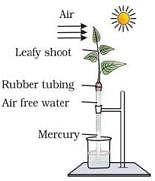 Ans. (a) The setup demonstrates effect of wind speed on rate of transpiration.
Ans. (a) The setup demonstrates effect of wind speed on rate of transpiration.
(b) If blower is placed close to the setup, this will decrease the level of water. This happens because increased wind speed increases the rate of transpiration.
(c) Phenyl mercuric acetate will reduce the rate of transpiration. As a result, mercury level would go down.
|
223 videos|325 docs|294 tests
|
FAQs on NCERT Exemplar: Transport in Plants (Old NCERT) - Biology for Grade 11
| 1. What is the process of transport in plants? |  |
| 2. What is transpiration and how does it occur in plants? |  |
| 3. What is translocation and how does it occur in plants? |  |
| 4. What are the factors that affect the rate of transpiration in plants? |  |
| 5. How do plants adapt to reduce water loss through transpiration? |  |

|
Explore Courses for Grade 11 exam
|

|


















